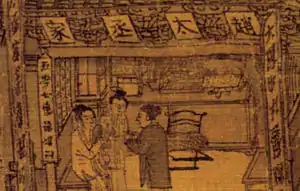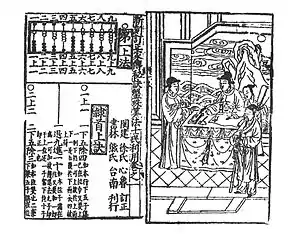Suanpan
The suanpan (simplified Chinese: 算盘; traditional Chinese: 算盤; pinyin: suànpán), also spelled suan pan or souanpan[1][2]) is an abacus of Chinese origin first described in a 190 CE book of the Eastern Han Dynasty, namely Supplementary Notes on the Art of Figures written by Xu Yue. However, the exact design of this suanpan is not known.[3] Usually, a suanpan is about 20 cm (8 in) tall and it comes in various widths depending on the application. It usually has more than seven rods. There are two beads on each rod in the upper deck and five beads on each rod in the bottom deck. The beads are usually rounded and made of a hardwood. The beads are counted by moving them up or down towards the beam. The suanpan can be reset to the starting position instantly by a quick jerk around the horizontal axis to spin all the beads away from the horizontal beam at the center.





Suanpans can be used for functions other than counting. Unlike the simple counting board used in elementary schools, very efficient suanpan techniques have been developed to do multiplication, division, addition, subtraction, square root and cube root operations at high speed.
The modern suanpan has 4+1 beads, colored beads to indicate position and a clear-all button. When the clear-all button is pressed, two mechanical levers push the top row beads to the top position and the bottom row beads to the bottom position, thus clearing all numbers to zero. This replaces clearing the beads by hand, or quickly rotating the suanpan around its horizontal center line to clear the beads by centrifugal force.
History


The long scroll Along the River During Qing Ming Festival painted by Zhang Zeduan (1085–1145) during the Song Dynasty (960-1279) might contain a suanpan beside an account book and doctor's prescriptions on the counter of an apothecary. However, the identification of the object as an abacus is a matter of some debate.[4]
The word "abacus" was first mentioned by Xu Yue(160–220) in his book suanshu jiyi (算数记遗), or Notes on Traditions of Arithmetic Methods, in Han Dynasty. As it described, the original abacus had five beads (suan zhu) bunched by a stick in each column, separated by a transverse rod, and arrayed in a wooden rectangle box. One in the upper part represents five and each of four in the lower part represents one. People move the beads to do the calculation.
A 5+1 suanpan appeared in Ming dynasty, an illustration in a 1573 book on suanpan showed a suanpan with one bead on top and five beads at the bottom.
The evident similarity of the Roman abacus to the Chinese one suggests that one must have inspired the other, as there is strong evidence of a trade relationship between the Roman Empire and China. However, no direct connection can be demonstrated, and the similarity of the abaci could be coincidental, both ultimately arising from counting with five fingers per hand. Where the Roman model and Chinese model (like most modern Japanese) has 4 plus 1 bead per decimal place, the old version of the Chinese suanpan has 5 plus 2, allowing less challenging arithmetic algorithms. Instead of running on wires as in the Chinese and Japanese models, the beads of Roman model run in grooves, presumably more reliable since the wires could be bent.
Another possible source of the suanpan is Chinese counting rods, which operated with a place value decimal system with empty spot as zero.
Beads
There are two types of beads on the suanpan, those in the lower deck, below the separator beam, and those in the upper deck above it. The ones in the lower deck are sometimes called earth beads or water beads, and carry a value of 1 in their column. The ones in the upper deck are sometimes called heaven beads and carry a value of 5 in their column. The columns are much like the places in Indian numerals: one of the columns, usually the rightmost, represents the ones place; to the left of it are the tens, hundreds, thousands place, and so on, and if there are any columns to the right of it, they are the tenths place, hundredths place, and so on.
The suanpan is a 2:5 abacus: two heaven beads and five earth beads. If one compares the suanpan to the soroban which is a 1:4 abacus, one might think there are two "extra" beads in each column. In fact, to represent decimal numbers and add or subtract such numbers, one strictly needs only one upper bead and four lower beads on each column. Some "old" methods to multiply or divide decimal numbers use those extra beads like the "Extra Bead technique" or "Suspended Bead technique".[5]
The beads and rods are often lubricated to ensure quick, smooth motion.
Calculating on a suanpan
At the end of a decimal calculation on a suanpan, it is never the case that all five beads in the lower deck are moved up; in this case, the five beads are pushed back down and one carry bead in the top deck takes their place. Similarly, if two beads in the top deck are pushed down, they are pushed back up, and one carry bead in the lower deck of the next column to the left is moved up. The result of the computation is read off from the beads clustered near the separator beam between the upper and lower deck.
Division
There exist different methods to perform division on the suanpan. Some of them require the use of the so-called "Chinese division table".[6]
| Chinese Division Table | |||||||||
|---|---|---|---|---|---|---|---|---|---|
| 一 1 | 二 2 | 三 3 | 四 4 | 五 5 | 六 6 | 七 7 | 八 8 | 九 9 | |
| 一 1 | 进一 advance 1 | Cycle repeats | |||||||
| 二 2 | 添作五 replace by 5 | 进一 advance 1 | Cycle repeats | ||||||
| 三 3 | 三十一 31 | 六十二 62 | 进一 advance 1 | Cycle repeats | |||||
| 四 4 | 二十二 22 | 添作五 replace by 5 | 七十二 72 | 进一 advance 1 | Cycle repeats | ||||
| 五 5 | 添作二 replace by 2 | 添作四 replace by 4 | 添作六 replace by 6 | 添作八 replace by 8 | 进一 advance 1 | Cycle repeats | |||
| 六 6 | 下加四 below add 4 | 三十二 32 | 添作五 replace by 5 | 六十四 64 | 八十二 82 | 进一 advance 1 | Cycle repeats | ||
| 七 7 | 下加三 below add 3 | 下加六 below add 6 | 四十二 42 | 五十五 55 | 七十一 71 | 八十四 84 | 进一 advance 1 | Cycle repeats | |
| 八 8 | 下加二 below add 2 | 下加四 below add 4 | 下加六 below add 6 | 添作五 replace by 5 | 六十二 62 | 七十四 74 | 八十六 86 | 进一 advance 1 | Cycle repeats |
| 九 9 | 下加一 below add 1 | 下加二 below add 2 | 下加三 below add 3 | 下加四 below add 4 | 下加五 below add 5 | 下加六 below add 6 | 下加七 below add 7 | 下加八 below add 8 | 进一 advance 1 |
The two most extreme beads, the bottommost earth bead and the topmost heaven bead, are usually not used in addition and subtraction. They are essential (compulsory) in some of the multiplication methods (two of three methods require them) and division method (special division table, Qiuchu 九歸, one amongst three methods). When the intermediate result (in multiplication and division) is larger than 15 (fifteen), the lowest of the upper beads is moved halfway to represent ten (xuanchu, suspended). Thus the same rod can represent up to 19 (compulsory as intermediate steps in tradition suanpan multiplication and division).
The mnemonics/readings of the Chinese division method [Qiuchu] has its origin in the use of bamboo sticks [Chousuan], which is one of the reasons that many believe the evolution of suanpan is independent of the Roman abacus.
This Chinese division method (i.e. with division table) was not in use when the Japanese changed their abacus to one upper bead and four lower beads in about the 1920s.
Decimal system
This device works as a bi-quinary based number system in which carries and shifting are similar to the decimal number system. Since each rod represents a digit in a decimal number, the computation capacity of the suanpan is only limited by the number of rods on the suanpan. When a mathematician runs out of rods, another suanpan can be added to the left of the first. In theory, the suanpan can be expanded indefinitely in this way.
Hexadecimal system
It has been suggested that at one time or another, a way of using the seven beads on each wire to represent hexadecimal digits was used to add and subtract Chinese weights, where one jin (斤) equals sixteen liang (兩). Such a method would not work on a soroban, since only 10 combinations rather than 18 are available on each rod.
Decline in modern usage
Suanpan arithmetic was still being taught in school in Hong Kong as recently as the late 1960s, and in China into the 1990s. However, when hand held calculators became readily available, school children's willingness to learn the use of the suanpan decreased dramatically. In the early days of hand held calculators, news of suanpan operators beating electronic calculators in arithmetic competitions in both speed and accuracy often appeared in the media. Early electronic calculators could only handle 8 to 10 significant digits, whereas suanpans can be built to virtually limitless precision. But when the functionality of calculators improved beyond simple arithmetic operations, most people realized that the suanpan could never compute higher functions – such as those in trigonometry – faster than a calculator. Nowadays, as calculators have become more affordable, suanpans are not commonly used in China, but many parents still send their children to private tutors or school- and government- sponsored after school activities to learn bead arithmetic as a learning aid and a stepping stone to faster and more accurate mental arithmetic, or as a matter of cultural preservation. Speed competitions are still held. Suanpans are still being used elsewhere in China and in Japan, as well as in some few places in Canada and the United States.
In mainland China, formerly accountants and financial personnel had to pass certain graded examinations in bead arithmetic before they were qualified. Starting from about 2002 or 2004, this requirement has been entirely replaced by computer accounting.
Notes
- Schmid, Hermann (1974). Decimal Computation (1 ed.). Binghamton, New York, USA: John Wiley & Sons. ISBN 0-471-76180-X.
- Schmid, Hermann (1983) [1974]. Decimal Computation (1 (reprint) ed.). Malabar, Florida, USA: Robert E. Krieger Publishing Company. ISBN 0-89874-318-4.
- Peng Yoke Ho, page 71
- Martzloff, p. 216
- "算盤 Traditional Multiplication Techniques for Chinese Abacus - Chinese Suan Pan". Webhome.idirect.com. Retrieved 2013-03-26.
- "算盤 Short Division on a Chinese Abacus - Chinese Suan Pan". Webhome.idirect.com. Retrieved 2013-03-26.
See also
References
External links
- Suanpan Tutor - See the steps in addition and subtraction
- A Traditional Suan Pan Technique for Multiplication
- Hex to Suanpan